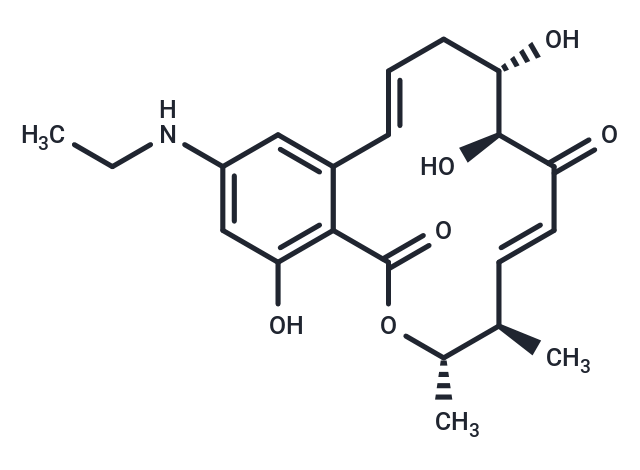Shopping Cart
- Remove All
 Your shopping cart is currently empty
Your shopping cart is currently empty

E6201 (ER-806201) is a potent dual kinase inhibitor targeting MEK1 and FLT3, inhibiting their activities in an ATP-competitive manner. It effectively suppresses MEK1-induced ERK2 phosphorylation (IC50 = 5.2 nM), MKK4-induced JNK phosphorylation (IC50 = 91 nM), and MKK6-induced p38 MAPK phosphorylation (IC50 = 19 nM). E6201 exhibits anti-tumor and anti-psoriasis effects [1] [2].

| Pack Size | Price | Availability | Quantity |
|---|---|---|---|
| 25 mg | $1,520 | 10-14 weeks | |
| 50 mg | $1,980 | 10-14 weeks | |
| 100 mg | $2,500 | 10-14 weeks |
| Description | E6201 (ER-806201) is a potent dual kinase inhibitor targeting MEK1 and FLT3, inhibiting their activities in an ATP-competitive manner. It effectively suppresses MEK1-induced ERK2 phosphorylation (IC50 = 5.2 nM), MKK4-induced JNK phosphorylation (IC50 = 91 nM), and MKK6-induced p38 MAPK phosphorylation (IC50 = 19 nM). E6201 exhibits anti-tumor and anti-psoriasis effects [1] [2]. |
| In vitro | E6201 is distinguished as an inhibitor explicitly targeting the MEKK1 and MEK families, without impacting the MAPK family members, demonstrating selective inhibitory effects on MEKK1-induced phosphorylation of MEK1, MKK4, and MKK6 (IC50 values: 31, 522, and 65 nM, respectively). Notably, at a concentration of 10 μM, E6201 does not influence other proteins in the MAPK family such as ERK2, JNKs, and p38 MAPK. Its capability extends to thwarting LPS-induced TNF transcription (IC50: 50±14 nM) while barely affecting β-actin transcription up to concentrations of 3 μM. E6201 also shows inhibitory actions on specific receptor tyrosine kinases—including VEGFR2, PDGFR, the hepatocyte growth factor receptor, and EGFR (IC50 values: 350, 860, 1100, and 5400 nM, respectively)—and the nonreceptor tyrosine kinase Syk (IC50: 460 nM), while sparing ZAP-70, IKK, and PKC activity even at elevated concentrations of 10 μM and 100 μM, respectively. This compound further inhibits IL-2 production post-PHA-P activation (IC50: 18 nM), curtails proliferation of EGF-stimulated human keratinocytes (IC50: 160 nM), and suppresses IL-8 production in keratinocytes post-IL-1α or TNFα stimulation (IC50 values: 60 and 30 nM, respectively). Additionally, E6201 effectively inhibits production of TNFα, IL-1, IL-6, and IL-8 in human PBMCs (IC50 values: 20, 16, 52, and 53 nM, respectively), showcases potent inhibition of triple-negative breast cancer (TNBC) cell proliferation and colony formation in a dose-dependent manner, induces G1 phase cell cycle arrest, and triggers apoptosis in TNBC cells at 1 μM, substantiated by a significant reduction in phospho-ERK expression levels and sustained effects observed through Western Blot Analysis. |
| In vivo | Administering E6201 (30 mg/kg; via tail vein injection three times per week) demonstrated prominent inhibition of TNBC xenograft tumor growth and significantly reduced pERK and Ki-67 expression in xenograft tumor tissues [2]. The study utilized female Nod.Scid gamma mice, aged 4 to 6 weeks, implanted with MDA-MB-231-LM2 xenograft tumors [2]. Over a period of 17 days, the dosage and method of administration remained consistent. Compared to mice receiving a vehicle control, those treated with E6201 exhibited a 60% suppression in tumor growth. |
| Molecular Weight | 389.44 |
| Formula | C21H27NO6 |
| Cas No. | 603987-35-5 |
| Storage | Powder: -20°C for 3 years | In solvent: -80°C for 1 year | Shipping with blue ice. |

Copyright © 2015-2025 TargetMol Chemicals Inc. All Rights Reserved.